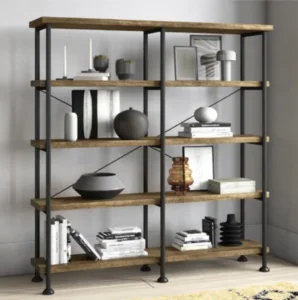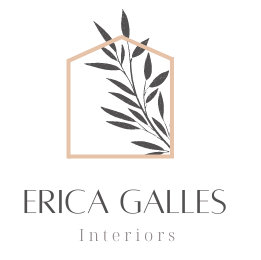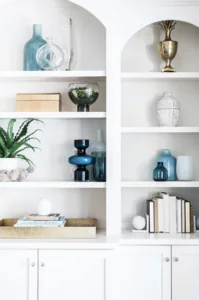Styling a bookcase is an art form that can transform a simple storage unit into a visually appealing focal point within a room. When done right, it can elevate the overall interior design and create a cohesive look that ties the space together.
Before you begin, empty the bookcase completely, removing all books and objects, allowing you to visualize the space and plan your design more effectively. Although it may seem easier to keep some items on your shelves before restyling, trust me it’s not. This step ensures that you have a fresh canvas to work with. Also, by removing all the items, you will have a fresh perspective and it may open your eyes to incorporating the objects in a different way.
The first step when styling bookshelves is to decide on a color scheme. This is an essential step in creating a cohesive design. Consider the existing colors in the room and select decorative items that complement or accentuate those colors. This could involve incorporating items in similar or complementary hues. For instance, if the room features a neutral palette, you might opt for a mix of earthy tones or subtle pops of color to add visual interest.
The picture below is a wonderful example of a neutral, mostly monochromatic design. This is beautiful in a very refined and elegant way and it contrasts dramatically with the pops of color in the other example below.

The designer from Studio DIY Blog used blues, teals, greens, and pinks to style her bookcase. It coordinates with the rest of the house and acts as a visual clue as to what you will see elsewhere in the house. It’s very different than the monochromatic, neutral shelf styling that has become synonymous with designers like Studio McGee. Both are correct and one is not more beautiful than the other – you just need to decide what you want your color scheme to be and the overall direction of your design aesthetic.

Now that you have some sense of how to choose a color scheme and arrange the shelves, the tough part happens – what to choose to style your bookcase. A bookcase offers an opportunity to showcase decorative items that contribute to the cohesive design. Integrate a mix of objects throughout the shelves, including sculptures, framed photos, decorative boxes, candles, and plants. Texture plays a vital role in adding depth and visual interest to a bookcase. Incorporate items with different textures, such as woven baskets, textured vases, or decorative boxes. These elements break up monotony and add dimension to the display. Ensure these objects align with your chosen color scheme and overall design style. For instance, if your theme is minimalist, opt for clean lines and simple shapes, whereas a more eclectic style might call for a mix of textures and patterns. To make the bookcase truly yours, infuse it with personal touches. Incorporate items that reflect your interests, hobbies, or travels. These could be souvenirs, mementos, or items with sentimental value. Personal touches add authenticity and make the bookcase feel uniquely yours, contributing to the overall cohesion of the design. Books are not only functional but can also serve as design elements within a bookcase. Organize your books strategically to create visual interest. One approach is to arrange them by color, creating a visually pleasing gradient or pattern. Alternatively, you can group books by size or subject matter, creating sections that bring cohesion to the overall display. Interspersing vertical book placement with horizontal stacks or bookends can help break up the lines and add dimension.
House Beautiful years ago presented this article about rainbow styling a bookshelf. This would be amazing in a playroom or children’s bedroom but personally, keeping it organized would drive me crazy. I just know my kids would never put the books back in the right spot!
To create visual balance and avoid monotony, incorporate objects of varying heights, proportions, shape, and scale. This technique adds depth and interest to the bookcase display. Place taller decorative items, such as vases or sculptures, alongside shorter objects like picture frames or small plants. The interplay of heights ensures a dynamic and engaging composition. And don’t forget to layer! Layering objects can also create a sense of depth, with items overlapping and peeking out from behind others. This technique enhances the visual appeal and creates a more curated look. It’s ok to place an object slightly in front of a picture or large photo. In addition to layering, balance is also crucial in creating a cohesive bookcase display. When designers refer to balance, however, we are not only referring to spacial balance, but also balance of color. Arrange objects in a way that creates a sense of symmetry or visual equilibrium. Placing larger items on the bottom or middle shelves, and gradually scaling down the size as you move up, helps establish balance. Consider mirroring similar objects on opposite sides of the bookcase to create a harmonious and visually pleasing arrangement. For example, if you have brass candlesticks on one side of the bookcase, bring in a brass bowl or brass picture frame on another shelf on the opposite side.
Lastly, embrace negative space. While it may be tempting to fill every inch of the bookcase, it is important to embrace negative space. Leaving some empty space on the shelves creates breathing room and prevents the display from appearing cluttered. Negative space also helps highlight key objects and allows each item to stand out. Striking the right balance between filled and empty spaces is crucial in achieving a cohesive and visually pleasing look. The photo below from The Scout Guide is a perfect example of how expertly the designer layered the objects, assembled a wonderful balance of color and textures, and embraced the negative space on the shelves. Most importantly, have fun and don’t be afraid to think out of the box with your objects! It’s amazing how much joy it can bring to see your beloved objects, books, and photos displayed in a cohesive way on your shelves.



